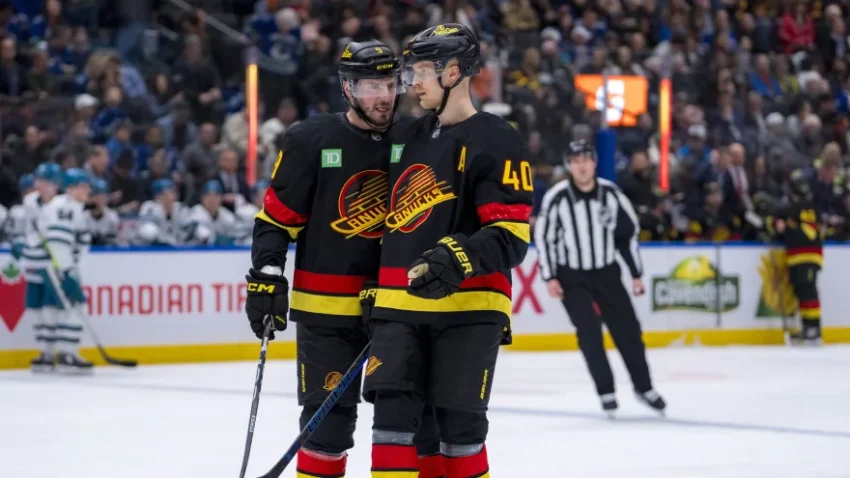
The Vancouver Canucks have a problem. Actually, that’s a wild understatement. The Vancouver Canucks have a multitude of problems.
The problem that’s caught the attention of both local and national media is the internal rift between J.T. Miller and Elias Pettersson. Outside of hockey, there are several ways to solve problems. Within hockey, there are usually two solutions to every problem. The first is to fire the coach. The second is to get rid of the player. The Canucks will not be getting rid of Rick Tocchet any time soon. That leaves option number two as the most logical step.
Now, all this assumes Miller and Pettersson can’t solve their problems. As much as everyone calls for the two to act like adults, there are certain situations where you are just around someone you revile and the only way to go on with your life is to cut them out of it. If one or both are insisting that’s the case, then there really isn’t any other logical option than to trade one of them.
Once a commitment is made to trade one or both of them, the next step would be to solicit offers. I don’t know about you, but I’m not a General Manager of an NHL team. I’ve never worked in the front office of a major sports organization. I’m not even a connected hockey insider who can call up management teams or agents and ask questions. I can look through past trades, offer up some comparables, and use those as a baseline for what a trade of either player would look like.
One stumbling block in finding comparables for both players is that they are each in rare situations regarding their age, production, and contract status.
J.T. Miller
He’s 31 years old, turns 32 in March, and has averaged more than a point per game in the regular season since joining the Canucks. He is signed for five more seasons at an $8M cap hit with a full no-movement clause for this season. His no-movement clause becomes a 15-team no-trade clause in the last three seasons of his contract. He takes up 9.1% of the salary cap. It’s rare for a player as productive, on a long-term contract, and in his 30s to get traded. Though, there is a very recent example: Tomáš Hertl.
Hertl was traded at last season’s trade deadline. He was one year younger than Miller is now and had six seasons left on his contract. Like Miller, Hertl is a centre and has a full no-move clause. However, there is one stark difference between the two: Miller has been a far more productive player since coming to Vancouver than Hertl has been during the same time frame.
Prior to being traded, Hertl averaged 0.78 points per game (PPG) in the 307 games he played since Miller joined the Canucks, a significant drop from Miller’s. Over the same time frame, Miller has played 364 games with a 1.10 PPG. This should reflect a substantial value difference between the two players, and Miller should have quite a bit more value and not require any retention in order to garner a greater return than Hertl.
Edstrom was the last player selected in the first round of the 2023 draft, and the first-round pick the Sharks acquired from the Golden Knights in 2024 was 27th overall. Both are good assets, but neither, or an equivalent, would have any particular interest to the Canucks. As it turns out, neither were actually that highly thought of by the Sharks either, as both were flipped – along with goalie prospect Magnus Chrona – to the Nashville Predators for goaltender Yaroslav Askarov and other minor pieces.
Still, this is the best recent comparable. It’s not necessarily useful in constructing an accurate trade proposal but stands as a firm floor when figuring out trade value. Miller is a better player with a lower cap hit for fewer years than when Hertl was traded. Therefore, will have a greater return in asset value.
Elias Pettersson
While trading a young point-per-game centre right as their long-term contract kicks in is rare, it has happened before. There are four good examples of this, and while three of them happened over 10 years ago, the general framework of the trades is still relevant.
The parameters for Pettersson are pretty basic: Mid-20s, signed to a long-term contract, no trade protection (in the first year), plays centre, and close to Pettersson’s production. Of all the trades listed below, Pettersson takes up the highest percentage of the cap at 13.2%, but he also has the highest points per game (0.99 PPG) of all these players.
The first comparable we’ll look at is Jeff Carter getting traded from the Philadelphia Flyers to the Columbus Blue Jackets. Carter had signed a massive 11-year extension the season prior, but the Flyers traded him before it began.
Carter and Pettersson’s goal scoring is indistinguishable from each other (181 goals for Carter vs. 180 goals for Pettersson), but Pettersson’s playmaking far outpaces Carter. Additionally, Carter’s points per game is the lowest of Pettersson’s comparables at 0.74 PPG. At the time of the trade, Carter’s cap hit took up 8.2% of the salary cap.
Vorcak, at the time, was a 22-year-old with three full NHL seasons under his belt while averaging about 46 points a season. He was a former seventh-overall pick and very highly thought of. The first-round pick was eighth overall in the 2011 draft, and the Flyers took Sean Couturier. This was quite a good return, given that these two assets held a lot of value.
